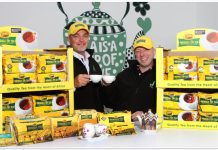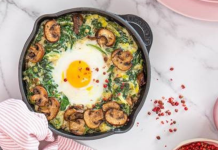Whether it’s green, black, rooibos, herbal or oolong, with or without milk, flavoured or plain – tea is one of the globe’s most well-loved beverages. In fact, South Africa ranks 13 out of 55 tea drinking countries in the world in terms of our tea consumption. To celebrate this fact, Joekels Tea Packers, tea experts and manufacturers of leading tea brands including Tetley and Laager Rooibos, is giving the public the chance to test its tea knowledge on the nuances around different types of tea, tea preparation and tea consumption.
“For many South Africans, tea has played an integral role in every phase of their life,” said Candice Sessions, Joekels Marketing Manager. “We are very passionate about tea, and wanted to pass on some of this knowledge to other self-confessed ‘teapots’. Why not see how many of these true or false questions you know the answer to – some of the answers may surprise you!”
1. Rooibos is not actually a tea
True! Rooibos is actually a herbal tincture made from the aspalathus linearis bush, while all ‘true’ teas – black tea, green tea, white tea and oolong – originate from the camellia sinensis plant. This is also the reason that Rooibos is naturally caffeine-free. This fact, among many other natural health benefits, have seen Rooibos become a popular drink worldwide.
2. Rooibos is grown all over the whole world
False! Rooibos is only grown in one region in the world – the Cederberg Mountains of the Western Cape. Other regions across the globe have tried to produce Rooibos – and failed – due to the fact that it requires a very unique set of climactic conditions in order to thrive.
3. Rooibos can be given to young children
True! Because Rooibos is naturally caffeine-free, it is safe for young children. It is also rich is many natural health benefits, meaning that it’s the ideal choice for growing bodies. Laager Tea4Kidz is one range of Rooibos tea specifically designed for children. However, Laager and Tea4Kidz partner dietician, Mapholi Mapholi said it’s important to note that Rooibos tea should never replace milk for babies.
“Rooibos tea is healthy and suitable for babies that are at a recommended age to start eating and drink other foods and drinks – depending on a baby’s readiness or at six months,” she said. “However, Rooibos tea cannot replace milk. Babies need milk – breast milk or formula – as a primary source of nutrients for at least 1 to 2 years of their life.”

4. Teabags were created by accident
True! The first tea bags were created in the early 1900s in the United States by Thomas Sullivan. He originally created small silk bags to house samples of his tea to give to his customers. Some thought that the bags were intended to be put directly into the tea pot rather than emptied out, and so the tea bag was born by accident!
5. Black tea and green tea come from the same plant
True! Green tea is made from the same plant as black tea, camellia sinensis, but it doesn’t go through the fermentation process that black tea does, so it retains a lot of its natural benefits.
6. Green tea is best prepared with boiling water
False! Green tea has a very delicate flavour, which can become bitter if prepared with boiling water. For optimum flavour, green tea should be prepared with water that hasn’t reached boiling point.
7. Adding milk to green tea enhances the health benefits
False! Green tea is best prepared without milk. Milk contains a protein called casein that negates some of the benefits of the natural antioxidants found in green tea. For those who find green tea too bitter, a squeeze of honey or a slice of lemon is a good idea. Alternatively, there are flavoured green teas such as Tetley Green lemon, mint, or apple.
8. You should have a cup of green tea with every meal
False! Mapholi notes that green tea can inhibit the absorption of iron if consumed with meals. It should rather be drunk in between meals with at least 15 to 20 minutes between eating food and consuming green tea.
9. Green tea alone will burn fat
False! Although green tea does contain a stimulant to speed up metabolism, green tea should be drunk as a part of a healthy diet overall to enjoy the benefits of weight loss.
10. Regular black tea isn’t healthy
False! All teas have their own unique health benefits, including black teas. While teas like Rooibos and green tea often hold the spotlight in terms of health benefits, regular tea has its own set of benefits – including aiding alertness and endurance, and helping to eliminate toxins from the body.
11. Earl Grey, English Breakfast, and Ceylon are varieties of black tea
True! Earl Grey is a flavoured black tea blend which includes bergamot (citrus) oil to give the tea floral notes. English Breakfast is a blend of strong black teas, and Ceylon is a black tea that is grown in Sri Lanka.
12. You shouldn’t re-boil water when making tea
True! The biggest mistake people make is re-boiling water throughout the day. Re-boiling water makes tea taste flat, which is why tea should always be prepared with freshly-boiled water. Rather than wasting water, use the cool boiled water for drinking or watering plants.
13. You should add milk first when making tea
False…and true! It’s really completely up to you. In days gone by, tea was an expensive drink enjoyed by the elite in fine bone China which would crack when hot water was poured directly into it. This started the ritual of adding milk first. However, if tea is brewed in the cup and not a teapot, then milk should be added once the teabag is removed to allow the tea to infuse properly.
14. Infusions are fruit teas
False! While many herbal and fruit infusions are referred to as teas, they are not actually tea as they don’t contain tea leaves – camellia sinensis. Instead, they are made from a blend of real herbs, flowers and fruit, which create a flavourful beverage when brewed in boiling water.
15. Tea is high in caffeine
False! While black tea and green tea do contain caffeine, it is at a much lower level than coffee. A cup of green tea contains roughly a third of the caffeine content found in a cup of instant coffee, and a quarter of the caffeine content found in a cup of filter coffee.
16. Master tea tasters add milk
True! Master tea blenders and tasters, like Jonathan Kelsey of Joekels Tea Packers, will add milk at the end when tasting teas so they can evaluate tea colour. A good quality black tea should have a reddish or golden hue to it once milk is added, while poorer quality teas are generally a flatter, brown colour.
17. Some Master Tea Blender’s insure their tongue and taste buds
True! The world’s top master tea blenders insure their tongue and taste buds against damage, due to the fact that their senses are so integral to the job they do and the fact that tea tasting and blending is a scarce skill. Jonathan Kelsey of Joekels Tea Packers has insured his tongue and taste buds for R5 million.
18. Tea is the most popular beverage in the world after municipal water
True! Tea is the second most popular beverage in the world due to a number of factors – it is widely available; it comes in a variety of different forms and flavours; it is affordable; and carries many health benefits.
19. Tea does not have an expiration date
False! The shelf life of tea is about 18-24 months. Over time, the powerful flavonoids found in tea are reduced. To get the most out of tea, it is best stored in an airtight container in a cool, dark place.
20. Tea can help you meet your daily fluid needs
True! However, it’s important to remember that caffeinated teas can cause you to lose some fluids, so should be drunk in moderation. Rooibos tea, however, is caffeine-free and can contribute to daily fluid requirements.
For more information about Joekels Tea Packers and their popular range of teas, visit www.joekels.co.za.






